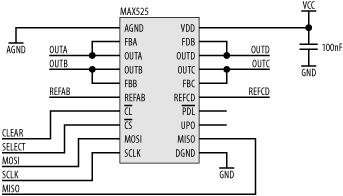Digital-to-Analog Conversion
So far, we have looked at how you can sense real-world effects and convert these into digital data. Now let’s see how to do the reverse: take digital data and convert it into an analog signal by using a chip known as a Digital-Analog Converter (DAC). We’ll also look at how you can produce an analog output using nothing more than a single digital I/O line.
All DACs have a digital input (either a microprocessor bus, SPI, or I2C) and will provide you with one or more channels of analog output.
The Maxim MAX525 is a 12-bit DAC that interfaces to a host processor using SPI. It has four channels of analog output and incorporates output amplifiers on-chip. The inverting inputs of both amplifiers are accessible so that you can alter their respective gains. An example circuit for a MAX525 is shown in Figure 12-21.

Figure 12-21. MAX525 circuit
The four analog output channels are OUTA, OUTB, OUTC, and OUTD. These are tied directly to their respective feedback inputs (FBA, FBB, FBC, and FBD) for standard unipolar operation. There are two voltage reference inputs, REFAB (for channels A and B) and REFCD (for channels C and D). These two reference inputs must be at least 1.4V or more below VCC at all times. The output voltage for each channel is given by the relation:
VOUT = (VREF * code / 4096) * gain
where code is the digital value written to that channel. In our example ...
Get Designing Embedded Hardware now with the O’Reilly learning platform.
O’Reilly members experience books, live events, courses curated by job role, and more from O’Reilly and nearly 200 top publishers.

